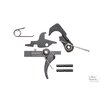Ethan Verity
Member
- Joined
- May 8, 2021
- Messages
- 716
In searching the internet, I don't think this point has been brought up before. It seems to me that most two-stage AR triggers are mechanically safer than single-stage triggers.
The single stage trigger has one sear engagement surface, and if it were to ever fail for some reason the gun would fully drop the hammer. Whereas most two-stage triggers have the primary 'two-stage' sear engagement, with the addition of a single-stage style sear engagement surface that is never actually used. If, for whatever reason, the two-stage sear were to break, the hammer would be caught by the secondary single stage sear to prevent a full hammer drop. I posted a picture below with the primary sear engagements circled in red, and pointed out the secondary single-stage sear on the two-stage trigger.

It's along the same lines as the firing pin block safety in a modern striker handgun; that second 'back up' if the sear were to ever fail. Personally, I like this design. I prefer to keep a round chambered in my defensive rifle, and chose the two stage trigger for this perceived added mechanical security benefit. I also like the feel of the two stage trigger.
The single stage trigger has one sear engagement surface, and if it were to ever fail for some reason the gun would fully drop the hammer. Whereas most two-stage triggers have the primary 'two-stage' sear engagement, with the addition of a single-stage style sear engagement surface that is never actually used. If, for whatever reason, the two-stage sear were to break, the hammer would be caught by the secondary single stage sear to prevent a full hammer drop. I posted a picture below with the primary sear engagements circled in red, and pointed out the secondary single-stage sear on the two-stage trigger.

It's along the same lines as the firing pin block safety in a modern striker handgun; that second 'back up' if the sear were to ever fail. Personally, I like this design. I prefer to keep a round chambered in my defensive rifle, and chose the two stage trigger for this perceived added mechanical security benefit. I also like the feel of the two stage trigger.




